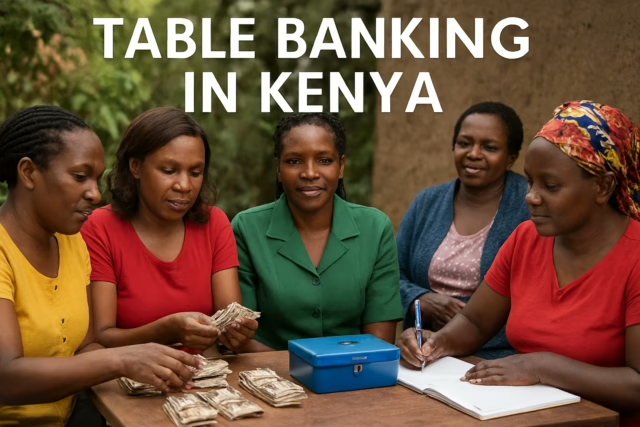In Kenya, a quiet but powerful financial revolution is taking place, not in the towering glass buildings of the banking industry, but around a simple table. This is the world of table banking, a community-driven financial model that has become a lifeline for millions of Kenyans, particularly those in underserved communities. It’s a system built on trust, mutual support, and collective action, providing a viable alternative to traditional banking for those who are often left behind.
This article explores the transformative power of table banking, diving deep into its mechanics, its profound socio-economic impact, and its role in fostering a culture of savings and entrepreneurship. It’s a story of how a simple concept is empowering individuals and strengthening communities, one meeting at a time.
From “Merry-Go-Round” to a Financial Lifeline
The roots of modern table banking in Kenya can be traced back to a deeply ingrained cultural practice: the “merry-go-round”. In these informal rotating savings and credit associations (ROSCAs), members would contribute a fixed amount of money periodically, with the entire sum being given to one member on a rotational basis. This practice, built on mutual trust, provided a natural foundation for the evolution of a more structured financial model.
Table banking took this familiar concept and added a crucial element: immediate borrowing and interest on loans. This shift transformed it from a simple savings mechanism into a dynamic, self-sustaining financial institution. The core principle is straightforward: members pool their savings, and this communal fund becomes a source from which they can borrow instantly during group meetings. The emphasis is on building financial assets through savings, rather than solely accumulating debt. This approach has proven particularly effective in poverty eradication, as championed by initiatives under Kenya’s former Poverty Eradication Commission.
Today, this model has spread to over forty-three counties, with an estimated 300,000 groups holding collective savings exceeding Ksh 3 billion. It’s a testament to the model’s resilience and its ability to organically adapt to the financial needs of communities where formal banking is often inaccessible or intimidating.
The Inner Workings of Table Banking Groups
The operational framework of table banking is a masterclass in community governance. These groups are formed by community members and function as self-help entities, with their own self-established constitutions or by-laws.
A Women-Led Revolution
A striking feature of table banking is the overwhelming participation of women, who constitute approximately 97% of its members in Kenya. This is no accident. For many women, formal banking presents significant barriers, such as the need for collateral like land, which they often do not own. Table banking bypasses this, using social capital as a form of security, making it a powerful instrument for gender-specific empowerment. This high level of participation has not only given women a voice in their households and communities but has also had a significant impact on national savings.
The Power of Transparency and Peer Pressure
Meetings, typically held weekly or monthly, are the heart of the table banking model. During these gatherings, members place their savings and loan repayments directly on the table. This visible display of all financial transactions is a powerful mechanism for building trust and ensuring transparency. In a setting where formal record-keeping may be limited, this practice provides immediate, tangible proof of financial activities, and the immediacy of lending reinforces the direct link between collective savings and individual access to capital.
Financial Mechanisms That Work for the Community
The financial mechanisms are designed to be flexible and community-centric. Contributions can be as low as Ksh 25, making it accessible to individuals with very low incomes. A member’s contributions are recorded in a personal passbook, which serves as their “share” in the collective fund.
- Loans and Interest: Members can borrow from the collective savings pool with remarkably low interest rates—often as low as 1% per month, a stark contrast to the 12.39% average in conventional banks. A portion of these loans, as high as 76% in some studies, is used to boost small businesses and farming ventures. The interest earned is then aggregated and distributed to members as an annual bonus, which is particularly useful for covering significant expenses like school fees.
- The Group Guarantee: This is the model’s most innovative feature. Instead of traditional assets, a group of members act as collective guarantors for a borrower. This system leverages peer pressure and social sanctions as a form of collateral. If a member defaults, the entire group’s access to future loans is jeopardized, strongly motivating members to hold each other accountable for repayments. This reliance on social ties minimizes risk and makes credit accessible to those who would otherwise be excluded.
Financial Management Practices: A Self-Imposed Discipline
For a table banking group to succeed, it must embrace a strong sense of financial discipline. This self-imposed discipline is a testament to the members’ commitment to sustainability and fairness.
- Record Keeping: Meticulous record-keeping is crucial. Each transaction is documented in a passbook, providing the internal transparency necessary for members to trust the system and verify loan statuses.
- Debt and Credit Management: The groups have developed a sophisticated, albeit informal, approach to credit assessment that mirrors the “five Cs of credit” used in formal banking (character, capacity, capital, collateral, and conditions). Members use their intimate knowledge of each other’s reputation and financial situation to assess a borrower’s willingness and ability to repay. When a loan defaults, the group takes proactive measures to recover the funds, leveraging their social ties to maintain a positive relationship with the borrower.
- Cash Flow Management: Groups actively manage their cash flow to ensure they have enough liquidity for operations and timely loan disbursements, while also avoiding the unproductive hoarding of cash. This practice instills a pragmatic form of financial literacy among members.
The Profound Socio-Economic Impact
Table banking’s impact extends far beyond the financial sphere, acting as a powerful engine for social change and community development.
- Financial Inclusion and Empowerment: By providing an affordable and accessible alternative to formal banking, table banking significantly improves financial inclusion for low-income individuals. Its impact on women, in particular, is transformative, providing them with the means to support their families, start businesses, and acquire assets like land—addressing a historical disparity where less than 7% of women held title deeds.
- Building Livelihoods: The funds borrowed from table banking groups are primarily used as capital for livelihood projects. As the “pot compounds,” members transition from borrowing for basic household needs to undertaking more impressive projects like building rental houses or purchasing dairy animals, illustrating a clear path to upward economic mobility.
- Strengthening Social Capital: Beyond its financial benefits, table banking is a powerful tool for building social capital. The model inherently fosters a strong sense of community, trust, and cooperation. The shared financial goal provides a strong incentive for members to support each other, resolve disputes, and build robust social networks that extend far beyond financial transactions. This social capital acts as a non-financial form of collateral and risk mitigation, making the model more resilient than its formal counterparts.
Overcoming Challenges for a Sustainable Future
Despite its many advantages, table banking is not without its challenges. The most significant is loan defaults, which have historically led to the collapse of many groups. While peer pressure is a powerful deterrent, it cannot always overcome a genuine inability to repay due to severe financial hardship. Other risks include poor management practices, a lack of external regulatory oversight, and the challenge of scaling the model without diluting the social cohesion that makes it so effective.
However, the continued growth and success of table banking across Kenya prove that its benefits often outweigh its risks. It stands as a testament to the ingenuity of communities in creating their own solutions to systemic problems. The story of table banking is a powerful one of self-reliance and collective strength, demonstrating that true financial empowerment can be found not in complex systems, but in the simple act of coming together around a table.





